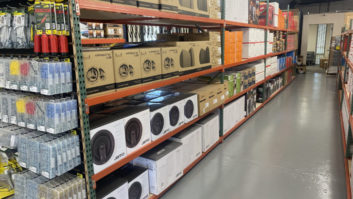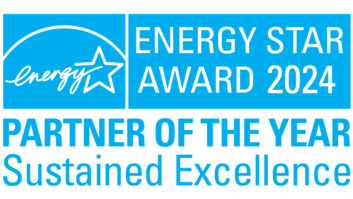NEW YORK — Consumer electronics and appliance merchants aren’t yellow when it comes to going green.
National chains including Best Buy, Sears and Staples are doing their fair share to keep industry products out of the waste stream and encourage conservation, while D&H Distributing is helping dealers identify eco-friendly
devices.
Effective last month, Best Buy expanded its CE recycling program to all of its 1,000-plus stores nationwide. Under the program, consumers can bring up to two items a day to any Best Buy store for recycling. The chain accepts most CE devices, including TVs and monitors up to 32 inches, computer CPUs and notebooks, small electronics, VCR and DVD players, phones, and accessories such as keyboards, mice and remotes.
Consumers must pay a $10 recycling fee for every item with screens but will be compensated on the spot with a $10 Best Buy gift card in exchange for the fee. (The fee does not apply in California or for any of Best Buy’s private-label products, which carry such brands as Insignia, Dynex and VPR Matrix, and the company won’t accept appliances.)
The program is the latest addition to the Best Buy’s recycling initiatives. Other efforts include:
•
recycling kiosks, located at the front of every store, which accept free drop offs of ink cartridges, rechargeable batteries, cellphones, CDs, DVDs and PDA/smartphones;
•
free removal of old TVs or appliances from a customer’s home when a new product is purchased and delivered by Best Buy’s home delivery or Geek Squad home-theater installation services; the company will also remove up to two appliances and/or TVs without a new purchase for $100, and will charge $20 for each additional unit;
•
trade-ins of used electronics in exchange for a Best Buy gift card, through an online partnership with Dealtree Services; and
•
The efforts are part of “Green Together,” a Best Buy initiative to help customers choose energy-efficient products and to work with employees, vendors and other suppliers to help reduce the company’s own carbon footprint.
Similarly, Sears launched a new program this month to help educate Americans about the millions of dollars in rebates that are available for Energy Star-rated products, and to help consumers receive their rebates faster.
The centerpiece of the program — which was an outcome of a recent Sears Energy Star “Summit” with the Department of Energy and the nation’s largest utility companies — is an online Energy Star rebate center, accessible through www.sears.com/appliances. The micro site allows customers to determine if a product qualifies for a rebate and what the maximum available rebate would be on an appliance purchase.
The site can also be accessed from easily identified research areas in most full-line Sears stores, where sales associates, now dubbed the Blue Appliance Crew, can walk customers through the online rebate-application process, eliminating the need to mail out tear sheets from home.
“We listened to our customers and know that they want to do the right thing by purchasing Energy Star-qualified products,” said Doug Moore, senior VP and president of home appliances at Sears. “Shoppers deserve their rebate money, and we want to make it as easy as possible.”
Sears sold more than 3.1 million Energy Star-rated majaps in 2008, reportedly the first retailer to do so, and last year’s sales of Energy Star-qualified Kenmore appliances alone helped Americans save nearly 700 million kilowatt hours, more than 4 billion gallons of water and more than $100 million dollars, the company said.
Staples, the office-products channel leader, is also doing its share by encouraging consumers to recycle ink and toner cartridges. The company provides customers with $3 back in “Staples Rewards” for choosing to recycle these products instead of throwing them away, and the rewards can be used on any Staples purchase in store, online or over the phone.
Staples recycled more than 22 million cartridges last year alone, and the chain expects to raise that number to more than 30 million in 2009 by expanding the program to include any brand or type of cartridge, regardless of manufacturer.
The chain cited recent studies showing that 70 percent of cartridges used worldwide are thrown away and almost eight cartridges are discarded per second in the United States alone, adding to the national e-waste problem and preventing tons of readily recyclable materials from being recovered and reused.
Staples’ current recycling programs also include cellphones, PDAs, computers and office technology, and last year it recycled approximately 4 million pounds of electronic waste.
“Staples continues to make it even easier for our customers to make a difference — what we call EcoEasy,” said Scott Rankin, VP/divisional merchandise manager, technology.
The company has also been a strong supporter of environmental conservation through sustainable business practices. It recently opened its first two stores registered with the U.S. Green Building Council’s Leadership in Energy and Environmental Design (LEED) program, and achieved LEED Gold certification for its Biscayne Boulevard store in Miami. In addition, all Staples Copy & Print Centers nationwide also use recycled paper certified by the Forest Stewardship Council (FSC) as the standard offering for black and white high-speed copy and print jobs.
Further up the distribution chain, D&H Distributing has added a “Go Green” online search tool refinement that identifies over 2,100 eco-friendly products from vendors including Garmin, Hewlett-Packard, Samsung, Sony, Toshiba and ViewSonic.
The distributor said that besides helping the planet, promoting eco-conservative solutions in the marketplace will give dealers and installers a competitive selling advantage and provide new sales opportunities, as consumers seek to save energy costs in the soft economy.
“The ecological impact of our ‘Go Green’ agenda is the primary motivation behind the campaign, which we have put into action through our own recycling and energy-saving efforts,” said Jeff Davis, senior sales VP. “We’re expanding that philosophy by giving our customers a means to take advantage of environmentally friendly products. This helps save the planet, gives our dealers an effective sales strategy and is a great way to show support for the vendor partners who developed this responsible merchandise.”
In addition to the “green” Web tool, D&H’s distribution centers and corporate office actively recycle paper, cardboard, wooden pallets and plastic. The company also uses energy-efficient lighting where possible, employs state-of-the-art conservation techniques and equipment at its newest distribution centers in Atlanta and Mississauga, Ontario, and has decreased the amount of packaging materials used in its shipping process to reduce waste.
all private-label Insignia LCD TVs manufactured after November 2008 meeting and often exceeding the latest Energy Star version 3.0 requirements.













